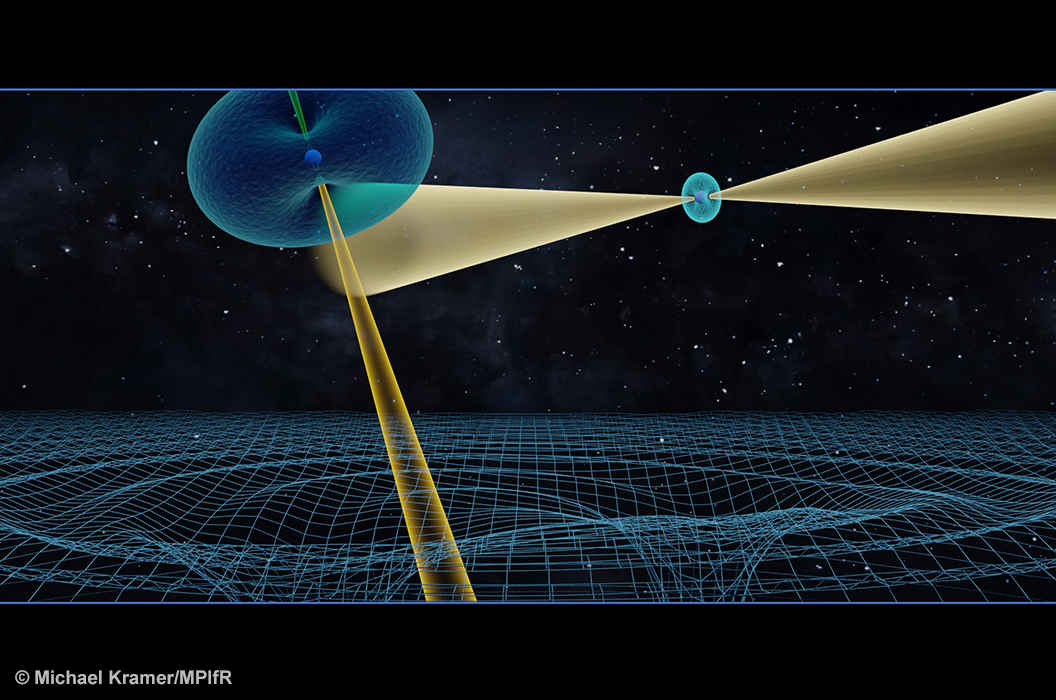 IHES
IHES
Einstein wins again
Press release – 13 December 2021
The theory of general relativity passes a range of precise tests set by pair of neutron stars
A 16-year long experiment involving six radio telescopes across the globe to study a unique pair of extreme stars called Double Pulsar and thus test Einstein’s theory of gravity has recently shown agreement with general relativity to an unprecedented precision. The results were published in Physical Review X. Prof. Thibault Damour, who is among the authors, contributed the theoretical framework underlying many of the results presented in the paper.
More than 100 years after Albert Einstein presented his theory of gravity, scientists around the world continue their efforts to observe deviations from general relativity, which would open a window on new physics beyond our current theoretical understanding of the Universe.
The experiment was carried out by an international team of researchers from ten countries, led by Prof. Michael Kramer from the Max Planck Institute for Radio Astronomy (MPIfR) in Bonn, Germany, who explains: “We studied a system of compact stars that is an unrivalled laboratory to test gravity theories in the presence of very strong gravitational fields. To our delight we were able to test a cornerstone of Einstein’s theory, the emission of gravitational waves, with a precision that is 25 times better than with the Nobel-Prize winning Hulse-Taylor pulsar, and 1000 times better than currently possible with gravitational wave detectors.”
Prof. Thibault Damour of the Institut des Hautes Etudes Scientifiques is among the physicists who emphasized the importance of binary pulsars as unique laboratories to test the strong-field and radiative regimes of Einstein’s theory. Together with some of his collaborators, he developed the theoretical framework used to interpret experimental data and account for any potential deviation from general relativity.
Not only are the observations in agreement with the theory but, thanks to their unparalleled precision, they also show relativistic effects that could not be measured before. The experiment shows the path that needs to be followed to test Einstein’s theory at an even higher precision and which subtle effects future experiments will need to take into account to maybe find a deviation from general relativity one day.
Research team
The research team consists of Michael Kramer, Ingrid H. Stairs, Richard N. (Dick) Manchester, Norbert Wex, Adam Deller, William A. Coles, Masooma Ali, Marta Burgay, Fernando Camilo, Ismaël Cognard, Thibault Damour, Gregory Desvignes, Robert Ferdman, Paulo C. C. Freire, Steffani Grondin, Lucas Guillemot, George B. Hobbs, Gemma Janssen, Ramesh Karuppusamy, Duncan R. Lorimer, Andrew G. Lyne, John W. McKee, Maura McLaughlin, L. Elias Münch, Nihan Pol, Andrea Possenti, John Sarkissian, Ben W. Stappers and Gilles Theureau.
Thibault Damour is a permanent professor at IHES.
The article by Michael Kramer et al. on Physical Review X DOI: 10.1103/PhysRevX.11.041050
Press release of the Max-Planck-Institut für Radioastronomie



